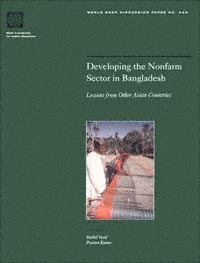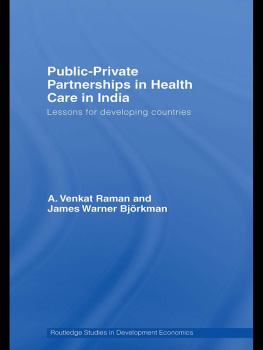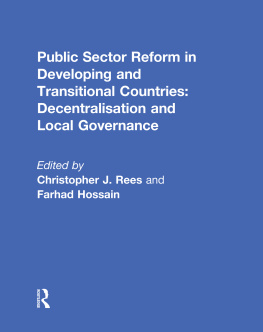Cover

| title | : | Developing the Nonfarm Sector in Bangladesh : Lessons From Other Asian Countries World Bank Discussion Papers ; 340 |
| author | : | Yusuf, Shahid.; Kumar, Praveen |
| publisher | : | World Bank |
| isbn10 | asin | : | 0821337262 |
| print isbn13 | : | 9780821337264 |
| ebook isbn13 | : | 9780585383866 |
| language | : | English |
| subject | Rural industries--Bangladesh, Economic forecasting--Bangladesh, Bangladesh--Economic conditions, East Asia--Economic conditions. |
| publication date | : | 1996 |
| lcc | : | HC440.8.Y87 1996eb |
| ddc | : | 338.095492 |
| subject | : | Rural industries--Bangladesh, Economic forecasting--Bangladesh, Bangladesh--Economic conditions, East Asia--Economic conditions. |
Page i
WORLD BANK DISCUSSION PAPER NO. 340
Developing the Nonfarm Sector in Bangladesh
Lessons from Other Asian Countries
Shahid Yusuf
Praveen Kumar
The World Bank
Washington, D. C.
Page ii
Copyright 1996
The International Bank for Reconstruction
and Development/THE WORLD BANK
1818 H Street, N.W.
Washington, D.C. 20433, U.S.A.
All rights reserved
Manufactured in the United States of America
First printing October1996
Discussion Papers present results of country analysis or research that are circulated to encourage discussion and comment within the development community. To present these results with the least possible delay, the typescript of this paper has not been prepared in accordance with the procedures appropriate to formal printed texts, and the World Bank accepts no responsibility for errors. Some sources cited in this paper may be informal documents that are not readily available.
The findings, interpretations, and conclusions expressed in this paper are entirely those of the author(s) and should not be attributed in any manner to the World Bank, to its affiliated organizations, or to members of its Board of Executive Directors or the countries they represent. The World Bank does not guarantee the accuracy of the data included in this publication and accepts no responsibility whatsoever for any consequence of their use. The boundaries, colors, denominations, and other information shown on any map in this volume do not imply on the part of the World Bank Group any judgment on the legal status of any territory or the endorsement or acceptance of such boundaries.
The material in this publication is copyrighted. Requests for permission to reproduce portions of it should be sent to the Office of the Publisher at the address shown in the copyright notice above. The World Bank encourages dissemination of its work and will normally give permission promptly and, when the reproduction is for noncommercial purposes, without asking a fee. Permission to copy portions for classroom use is granted through the Copyright Clearance Center, Inc., Suite 910, 222 Rosewood Drive, Danvers, Massachusetts 01923, U.S.A.
The complete backlist of publications from the World Bank is shown in the annual Index of Publications ,which contains an alphabetical title list (with full ordering information) and indexes of subjects, authors, and countries and regions. The latest edition is available free of charge from the Distribution Unit, Office of the Publisher, The World Bank, 1818 H Street, N.W., Washington, D.C. 20433, U.S.A., or from Publications, The World Bank, 66, avenue d'Ina, 75116 Paris, France.
Cover photo courtesy of The World Bank/Kay Chernush.
ISSN: 0259-210X
Shahid Yusuf is lead economist in the World Bank's Eastern Africa Department. Praveen Kumar is a consultant to the department and a professor at the University of Maryland.
Library of Congress Cataloging-in-Publication Data
Yusuf, Shahid, 1949
Developing the nonfarm sector in Bangladesh: lessons from other Asian countries / Shahid Yusuf, Praveen Kumar.
p. cm. (World Bank discussion papers; 340)
Includes bibliographical references.
ISBN0-8213-3726-2
1. Rural industriesBangladesh. 2. Economic forecastingBangladesh. 3. BangladeshEconomic conditions. 4. East AsiaEconomic conditions. I. Kumar, Praveen, 1960-. II. Title.III. Series.
| HC440.8.Y87 1996 | 96-32298 |
| 338.095492dc20 | CIP |
Page iii
CONTENTS
| Foreword | v |
| Abstract | vi |
| Acknowledegments | viii |
| Summary | ix |
|
| 1. Imperatives & Models | 1 |
|
| 2. Macroeconomic Trends in Bangladesh | 5 |
|
| 3. What Drives Growth? | 8 |
| Gross Domestic Savings | 9 |
| Gross Domestic Investment | 10 |
| Foreign Direct Investment | 10 |
| Public Finances | 11 |
| Human Capital | 11 |
| Health | 13 |
| Message from Indicators | 13 |
|
| 4. Pattern of Development | 14 |
| How Does Bangladesh Compare? | 15 |
| Devising a Strategy for Agricultural Intensification | 18 |
|
| 5 Choosing Appropriate Technologies | 21 |
|
| 6. Other Lessons from Comparative Experience | 24 |
| Lesson 1: Take Advantage of Location | 24 |
| Lesson 2: Promote Exports | 27 |
| Lesson 3: Develop Infrastructure | 28 |
| Lesson 4: Encourage Local Government Entrepreneurship | 29 |
| Lesson 5: Preparing for Industrialization | 31 |
|
| 7. Rural Industry in Bangladesh | 32 |
| Rural Infrastructure | 34 |
| Mechanical and Biochemical Technology | 38 |
| Neighborhood Effects | 39 |
|
Page iv
| 8. Rural Industry & Export-Led Growth | 41 |
| Possibilities for Foreign Investment | 41 |
| Domestic Hurdles | 43 |
| Financing of New Enterprises | 47 |
| Niche Exporting | 49 |
|
| 9. Growth Poles | 53 |
|
| 10. Concluding Observations | 60 |
|
| Tables and Charts | 64 |
| Bibliography | 88 |
| Map (IBRD 24206R) | 96 |
Page v
FOREWORD
Future growth of the Bangladeshi economy will be strongly influenced by the performance of the rural sector. Both the expansion of agricultural output and the development of the non-farm sector will play important roles, with the latter contributing more substantially to employment and potentially also to agro-based and manufactured exports. This study, which was prepared in connection with our ongoing work on Bangladesh's non-farm sector, explores the structure and dynamics of the rural economy in a comparative framework. It explores recent and potential sources of growth, in the process, providing a valuable spatial perspective on development processes. The study concludes with a wide-ranging policy agenda that gives due attention to the part that local governments can play through institution building, sound administration, resource mobilization, and entrepreneurship.
Next page






